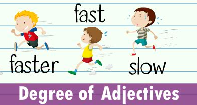Change Avatar
Degrees-of-adjectives
A gripping game that will not let you get enough of it until you complete all the levels. The game has been smartly designed for Fourth Grade kids to test their knowledge and identification power to pick up the correct degrees of adjectives. For this, they have to aim and shoot the correct moving dart as soon as the question pops up on the screen. Sounds exciting, know? Go for it!
How to play Degrees of Adjectives
Degrees of Comparison with Adjectives
What Are Degrees of Comparison with Adjectives?
There are three ways to write every adjective: positive, comparative, or superlative.
What is a Positive Degree?
Positive degree tells us that a quality exists. It has no comparison.
For example: fast, sad, scary, qualified
What is a Comparative Degree?
Comparative degree tells us about two things in a comparison, with one being the lesser and the other being the greater degree of a quality.
For example: faster, sadder, scarier, more qualified
What is a Superlative Degree?
Superlative degree tells that there are more than two things being compared, with one being either the least or greatest degree of a quality.
For example: the fastest, the saddest, the scariest, the most qualified
The easiest way to look at them is on a spectrum, from least to greatest.

As you can see, the chart shows positive, comparative, and then superlative.
When using them in writing, there are a few rules
How Do You Form Degrees of Comparison with Adjectives?
The positive form of the adjective is simply the adjective. In order to form the comparative or superlative form, you’ll have to follow some rules:
| Type of Adjective | Positive Degree | Comparative Degree Formation | Superlative Degree Formation |
|---|---|---|---|
| 1 syllable | tall | ADD -ER taller | ADD - EST talles |
| one syllable with vowel-consonant ending | red | DOUBLE CONSONANT + -ER redder | DOUBLE CONSONANT + -EST reddest |
| 2+ syllables | popular | ADD LESS or MORE less popular more popular | ADD MOST or LEAST most popular least popular |
| 2+ syllables ending in -Y | goofy | More=DROP -Y & ADD -IER goofier Less=ADD LESS less goofy | More - DROP -Y & ADD -IEST goofiest LESS=ADD LEAST least goofy |
| irregular | good bad little much far (extent) far (distance) many well old | better worse less more further farther more better elder | best worst least most furthest farthest most best eldest |
How Do You Use Them?
The Comparative Degree often uses the word “than” after the adjective when comparing two people or two things:
Positive - She is tall.
Comparative - She is taller than I am.
Exception: Some adjectives are followed by the word to instead of than:
Inferior, superior, junior, senior, prefer, elder, preferable, etc.
-This ice cream is inferior to the other brand.
The Superlative Degree often uses the word “the” in front of the adjective:
-She is the tallest sibling.
When comparing two degrees of a single person or thing, use the word “more.”
-She is more tall than short.
When something is exact or definite, you never use the word “more or most.”
-This line is perpendicular to the other.(“not more perpendicular or “most perpendicular”)
When the same group is compared, use the words “any other.”
-Sharona is faster than any other member of the track team.
Note: There are some phrases that can be comparative and function with superlative adjectives:
| by far the | This is by far the best pizza I’ve ever eaten. |
| one of the | This pizza is one of the best I’ve had. |
| the second (third, fourth, etc.) | This is the second best pizza I’ve ever eaten. |


